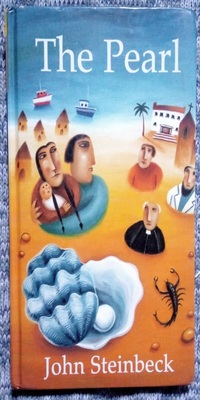The Pearl: Summary, Plot, Characters, Literary Analysis & More
“The Pearl” is a book by John Steinbeck, first published in 1947. This literary work stands as one of Steinbeck’s most acclaimed and influential creations.
“The Pearl” narrates the tale of Kino, a pearl diver from La Paz, whose life takes a dramatic turn when he discovers a magnificent pearl in the ocean.
The novella delves into themes of greed, human nature, and societal inequalities as Kino’s pursuit of wealth transforms his life and his family’s fate. In this review, we will provide a summary and delve into the literary analysis of this gripping narrative.

"The Pearl" narrates the tale of Kino, a pearl diver from La Paz, whose life takes a dramatic turn when he discovers a magnificent pearl in the ocean.
Table of Contents
Summary The Plot Characters Key Themes Genres Language used Literary devices Summing upThe Plot
In “The Pearl,” Kino, a skilled pearl diver, lives a modest life with his wife, Juana, and their infant son, Coyotito, in the coastal town of La Paz. One day, Kino discovers an immense pearl while diving.
This seemingly life-changing find ignites hope and ambition in Kino and Juana, but it also triggers a chain of tragic events.
Kino faces attacks, kills in self-defense, and refuses to sell the pearl at a low price. As they pursue their dreams, they are confronted by the dark forces of greed, leading to a heartbreaking conclusion.
Characters
Characters in “The Pearl” embody a range of human traits and motivations. From Kino’s unwavering determination to Juana’s steadfast support, each character contributes to the novella’s exploration of ambition, greed, and the human condition.
Kino
A skilled pearl diver in La Paz, Kino’s discovery of a valuable pearl sets off a series of life-altering events as he grapples with the allure of wealth and the dangers it brings.
Juana
Kino’s loving and resilient wife, Juana, serves as a pillar of strength, advocating for their family’s well-being and cautioning against the pearl’s malevolent influence.
Juan Tomas
Kino’s wise brother, Juan Tomas, offers counsel and insight, understanding the perils that come with possessing the immense pearl and the societal forces at play.
Key Themes
“The Pearl” explores profound themes that resonate with readers. It delves into the consequences of human desire, the corrupting influence of wealth, the struggles against societal injustice, and the innate goodness within individuals.
These themes captivate readers and provoke reflection.
Greed
The novel depicts how the allure of wealth, triggered by the discovery of the pearl, consumes Kino, leading to tragic consequences for his family and himself.
It serves as a cautionary tale about the destructive power of greed.
Inequality
The stark contrast between Kino’s impoverished life and the wealthier pearl dealers highlights the pervasive inequality in society. This theme underscores the unjust systems that perpetuate poverty and privilege.
Family
Kino’s unwavering devotion to his family, particularly his son Coyotito, showcases the theme of familial love and sacrifice. His actions are driven by a desire to provide a better life for his loved ones.
Human Nature
Through Kino’s journey, the novella examines the complexities of human nature, from ambition and fear to compassion and resilience. It reveals how individuals respond to external pressures and the moral dilemmas they face.
Genres in The Pearl
“The Pearl” belongs to the genre of classic literature and social commentary. Its powerful narrative style and vivid portrayal of societal issues make it a compelling work of both literary fiction and social critique.
Literary Fiction
John Steinbeck’s evocative prose and deep exploration of characters and themes elevate “The Pearl” to the realm of literary fiction.
It engages readers on intellectual and emotional levels, leaving a lasting impact.
Social Commentary
As a work of social commentary, “The Pearl” sheds light on the disparities and injustices present in society.
It encourages readers to reflect on issues such as wealth inequality, exploitation, and the human condition, fostering critical thinking and discussion.
Language used in The Pearl
John Steinbeck employs a vivid and evocative writing style in “The Pearl” to immerse readers in the story’s atmospheric and emotional landscape.
His prose skillfully captures the tension as Kino dives for pearls, the intimacy between Kino and Juana as they navigate their challenges, and the raw intensity of moments like Kino’s attacks and refusals.
Steinbeck’s language not only narrates the events but also conveys the characters’ inner struggles and the stark realities they face, creating a compelling and emotionally charged narrative.
Literary devices in The Pearl
In “The Pearl” by John Steinbeck, literary devices are artfully woven throughout the narrative to enhance its depth and impact. Steinbeck employs vivid imagery when describing the way Kino attacks and the way Kino kills, creating intense and emotionally charged scenes.
Symbolism is prevalent as Kino’s refusal to sell the pearl represents his resistance against societal oppression. Additionally, the author utilizes foreshadowing and irony to heighten suspense and provoke thought, making “The Pearl” a rich and layered literary work.
Similes
In “The Pearl” by John Steinbeck, the author utilizes similes to vividly describe and enhance the reader’s understanding.
For instance, when Kino refuses to sell the pearl, the author compares his resolve to “a boulder in the sun,” emphasizing Kino’s unyielding determination. This simile creates a powerful mental image, highlighting Kino’s unwavering stance.
Metaphors
Metaphors are also skillfully employed in the novel. When Kino throws the pearl back into the sea, it is described as “the pearl of the world.”
This metaphor underscores the immense value and potential the pearl holds, as well as the tragic loss when it’s discarded, conveying deeper themes of ambition and fate.
Similarly, the scorpion’s sting on Coyotito is likened to an “evil trickling down his shoulder,” symbolizing the maliciousness of fate and foreshadowing the challenges the family will face. These metaphors add layers of meaning to the narrative, engaging readers on a profound level.
Analogies
In John Steinbeck’s “The Pearl,” analogies serve as powerful tools to elucidate complex ideas and emotions. When Kino fights to protect his family, the comparison to “a man and a woman squaring off for a fight” paints a vivid mental picture of the intensity and desperation of the situation.
This analogy humanizes the struggle, making it universally relatable and allowing readers to empathize with Kino’s plight.
Analogies in the novella provide readers with familiar reference points, facilitating a deeper understanding of the characters’ experiences and the overarching themes of the narrative.
Imagery
Steinbeck’s masterful use of imagery in “The Pearl” transports readers into the heart of the story, creating sensory experiences that resonate long after the book is closed. When Kino hears mysterious noises, the “whispering of evil” conjures an eerie atmosphere, tinged with foreboding.
This imagery evokes a shiver down the reader’s spine, immersing them in the characters’ fears and anxieties.
Throughout the novella, from the treatment of Coyotito’s scorpion sting to Kino’s attempts to secure a better future, vivid imagery paints a rich tapestry of emotions and sensations, fostering a deep and lasting connection between readers and the narrative.
Symbolism
Several symbolic elements enrich the narrative and tie into broader themes. When Kino promises to provide a better life for his family with the pearl, it symbolizes hope and ambition.
As Kino believes in the pearl’s transformative power, it becomes a symbol of dreams and aspirations. When a scorpion stings Coyotito the act represents the sudden and cruel blows of fate, symbolizing the pervasive challenges faced by the impoverished and underscoring the theme of the unpredictable and often unjust nature of life.
Personification
Personification subtly breathes life into the characters and the setting. When Kino hears mysterious noises, the night is described as “alive with sounds.”
This personification endows the night with a living, almost sentient quality, intensifying the atmosphere of suspense and foreshadowing.
Additionally, when Juana tells Kino about the dangers of the pearl, her words are described as “heavy,” personifying her warning as a tangible force.
These instances of personification deepen the reader’s connection to the characters and their surroundings, heightening the emotional impact of the narrative.
Hyperbole
When Kino decides to pursue a new life with the pearl, the hyperbolic description of him preparing for this endeavor as “preparing for a hundred wars” magnifies the gravity of his decision.
This hyperbole underscores the magnitude of the choices made by the characters, emphasizing the weight of their actions and the consequences that follow.
It intensifies the narrative’s emotional resonance and highlights the significance of pivotal moments in the story.
Irony
Dramatic irony surfaces when Kino’s brother advises him to discard the pearl, as readers are aware of the pearl’s worth, creating tension.
Situational irony emerges when Kino hears noises in the night, seemingly ominous, but it turns out to be a harmless threat. This juxtaposition of expectation and reality adds suspense.
Furthermore, when Kino sneaks out to sell the pearl, situational irony arises as his actions inadvertently lead to tragic consequences. These ironies contribute to the novella’s sense of unpredictability and the exploration of the human condition.
Juxtaposition
Juxtaposition is a literary device that highlights stark contrasts, fostering thought-provoking scenarios.
One notable instance is when Kino attempts to treat Coyotito’s scorpion sting with a seaweed poultice.
The contrast between the humble remedy and the enormity of the pearl’s potential wealth underscores the disparity between Kino’s simple life and the world-altering consequences of the pearl’s discovery.
This juxtaposition prompts reflection on the juxtaposition between the ordinary and the extraordinary, poverty and prosperity, and the aspirations and realities of the characters.
Paradox
While “The Pearl” doesn’t rely heavily on paradoxical statements, it does contain paradoxes in the form of unexpected events.
For example, when Kino jumps into the sea to retrieve the pearl, the act symbolizes both hope and despair.
Allusion
“The Pearl” by John Steinbeck includes literary and historical allusions that enrich the narrative. When Kino finds the valuable pearl, it alludes to the biblical concept of a “pearl of great price,” symbolizing something of immense value.
This allusion adds depth to the significance of the pearl, highlighting its rarity and the sacrifices made to possess it.
Allegory
While “The Pearl” is not a straightforward allegory, it contains allegorical elements representing broader themes.
Kino’s journey to secure a better life through the pearl is allegorical of the universal human pursuit of dreams and the unforeseen challenges it entails.
The pearl itself serves as an allegorical representation of ambition, wealth, and the corrupting influence of materialism. These allegorical elements deepen the narrative’s exploration of timeless human dilemmas and societal issues.
Repetition
Repetition in “The Pearl” by John Steinbeck serves to underscore key themes and intensify emotional impact.
When Juana rushes to Kino’s aid or decides on a course of action, the repetition of her actions highlights her unwavering dedication to her family’s welfare.
Similarly, the repetition of Coyotito’s cries and Juana’s pleas to rid themselves of the cursed pearl amplifies the desperation and futility they feel in the face of mounting tragedy.
As Kino tells and continues to plan, the repetition underscores his determination, albeit misguided, and the relentless pursuit of his dreams, ultimately leading to a tragic climax.
The Use of Dialogue
dialogue plays a pivotal role in conveying character traits, highlighting themes, and building narrative tension.
When Juana rushes to Kino’s side and decides on their course of action, her dialogues reveal her unwavering determination and her deep commitment to her family’s well-being.
Kino’s opening of conversations with others and their responses provide insight into the dynamics of their relationships and the cultural context of their society.
When Coyotito cries and the characters’ attempts to convince Juana or tell Kino about the pearl intensify the emotional tension, emphasizing the stakes and the moral dilemmas they face, making dialogue a powerful tool in advancing the narrative.
Parallelism
In “The Pearl” by John Steinbeck, parallelism is subtly woven into the narrative, contributing to the story’s structure and message. The repetition of phrases like “Kino continues” and “Kino plans” underscores Kino’s persistent pursuit of his goals and his relentless determination to provide a better life for his family.
Similarly, the repeated motif of Juana carrying and recovering from various hardships parallels her unwavering strength and resilience.
The parallelism in the interactions with pearl dealers and other characters emphasizes the recurring themes of exploitation and the corrupting influence of wealth, adding depth and cohesion to the narrative while reinforcing its messages.
Rhetorical Devices
Rhetorical devices are strategically employed to create persuasive effects that resonate with readers. When Kino seeks to rid himself of the cursed pearl, the repetition of this desire, combined with parallelism, emphasizes the urgency of his decision.
Juana’s pleas and carrying Coyotito serve as poignant rhetorical appeals that highlight the family’s desperate situation and evoke empathy from the audience.
The pearl dealers’ offers to Kino and Juana are rhetorical devices that underscore the themes of exploitation and the corrupting allure of wealth, effectively engaging readers in a critical exploration of these issues.
The Pearl: FAQs
In this sectio of our “The Pearl” summary, you’ll find answers to common questions about John Steinbeck’s novella, its themes, characters, and literary elements. Dive deeper into the story and better understand this literary classic.
What is the main point of “The Pearl”?
“The Pearl” explores the devastating impact of unchecked greed and the corrupting influence of wealth on the lives of Kino and Juana, highlighting the tragic consequences that arise from their discovery of a valuable pearl.
What happened in the story of “The Pearl” with Kino and Juana?
In “The Pearl,” Kino, a pearl diver, and his wife Juana discover a valuable pearl that they hope will transform their impoverished life. However, their pursuit of a better future leads to escalating conflict, greed, and tragedy.
What happens when Kino kills Coyotito’s killers?
When Kino kills Coyotito’s killers in a desperate attempt to protect his family and the precious pearl, he sets off a chain of events that ultimately culminate in more violence, loss, and heartbreak, further illustrating the destructive nature of the pearl’s allure.
What happens when Kino dives to the seafloor?
When Kino dives to the seafloor in “The Pearl,” he hopes to find a valuable pearl that will improve his family’s life. His discovery of an immense pearl sets in motion a series of events that dramatically alter their fate.
Summing up: The Pearl: Summary, Plot & More
As you now know from this “The Pearl” summary, this work by John Steinbeck is a compelling tale that explores the human condition, societal inequalities, and the corrupting influence of wealth.
The summary of the story, from Kino’s initial dive for the pearl to the unfolding consequences for him and Juana, underscores the novel’s dramatic journey.
Its lasting impact lies in its ability to engage readers on both an intellectual and emotional level, prompting reflection on universal themes.
With its vivid characters and thought-provoking narrative, “The Pearl” continues to resonate, reminding us of the enduring power of literature to challenge our perspectives and ignite our empathy for those who grapple with the complexities of life.
Other Notable Works by John Steinbeck
If you are interested in “The Pearl”, you may be interested in other works by John Steinbeck including:
- “The Grapes of Wrath” (1939) – A classic novel that explores the struggles of the Joad family during the Great Depression, offering a powerful commentary on social and economic injustices.
- “Of Mice and Men“ (1937) – A poignant novella depicting the friendship between two displaced ranch workers during the same era, touching on themes of dreams, loneliness, and the human desire for companionship.
- “East of Eden” (1952) – An epic family saga set in California’s Salinas Valley, delving into themes of good and evil, inheritance, and the complexities of human nature.
- “Cannery Row” (1945) – A novel set in Monterey, California, portraying the lives of a group of colorful characters in a seaside town, offering a mix of humor and reflection on community and isolation.
- “Travels with Charley”: In Search of America” (1962) – A travelogue in which Steinbeck embarks on a cross-country journey with his dog Charley, exploring the landscapes and people of America.
These works showcase Steinbeck’s versatility and his ability to address diverse aspects of the American experience, making them worth exploring for anyone who appreciates his storytelling style and exploration of societal themes.







